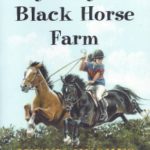Picture an average horse show: spectators in bleachers and folding chairs, babies in strollers, tractors, rakes, shovels, tack and other equipment in aisles. Now add a panicked, loose horse.

Looks pretty dangerous inside your head, doesn’t it?
At a horse show, exhibitors and show management must work together to make sure stabling areas are safe for everyone, events coordinator Nancy Easton says.
?Safety?is an easy thing to take care of,? she says, ?if people stay aware and are considerate of everything that’s going on around them.?
At a horse show, she says, ?the horse and exhibitor have a very tight bubble around them. Any noise or movement pushes into their bubble and causes them to react.?
Accidents Waiting to Happen
Many accidents happen because of a horse’s unexpected panic reaction.
?There is a reason for everything a horse does,? Nancy says. ?So whether an exhibitor is in the saddle or on the ground, he or she must be aware of the horse every second. And it’s important to see what’s going on around you–what the noises are, the visual triggers and other horses going by.?
What’s going on in the horse’s head can be another trigger.
?What a horse does might be a reactionto something that the handler has done at some other time,? she explains. ?The horse might hear a noise and associate it with a time when the handler jerked him or whipped on him, so he gets frightened, jumps and lunges forward.?
The leap is so instantaneous that a group of people in the way won?t have time to get clear.
?I have seen stall fronts pulled down and dragged through the alleyway,? Nancy says. ?Then all the other horses, both in stalls and out, also panic.?
Dangerous Clutter
When managing horse events at California?s state fair, Nancy does not allow exhibitors to leave objects in the alleys of the stable area. With thousands of spectators passing through during the fair, this reduces risks to both visitors and horses.
She cautions exhibitors at any show to avoid filling aisles with such things as wheelbarrows, gear, tables, chairs, bales of hay or coolers. These objects are better left in a tack or feed stall.
Groomingand tacking up horse in the aisleways can also court disaster.
Many people coming through the barn areas have never been close to a horse and might assume since it is tied in a ?public area,? that it is as safe to be around as a statue, she says.
If you decide to groom a horse in the alley, be aware of any foot traffic or other horses approaching. It is certainly not impolite to ask people to stay back or take another route through the barn, Nancy says. The same holds true for riders or handlers.
?Always ask the person who has the horse in the alleyway if it is safe for you to lead or ride by,? Nancy says.
Create a Visual Barrier
To keep foot traffic from going through a barn aisle, curtains at the end of the row are often effective. Even cones can provide a visual signal that this is not a public area.
?When I’m at the Congress or World Show and curtains are blocking off the alleyway, I don’t feel welcome to pass through there,? she says as an example.
She says the blockage doesn’t give her the feeling that the exhibitors using those stalls are unfriendly but rather that they are trying to create a safe environment for themselves and their horses. This is especially true when stallions are involved.
Caution! Stallion in the Stall!
Housing stallions at shows can be risky, especially if the horse is unruly. And even if the stallionisn?t normally a problem, things can become dangerous if a rider on a mare, for instance, comes down the alley and stops in front of the stallion?s stall.
Nancy says if management knows someone is bringing an unruly stallion, an end stall that is not in a high traffic area can be assigned. And, she says, care must be taken not to stable stallions next to each other.
?It’s never an easy situation to handle, but a lot of the safety certainly does depend on show management,? Nancy says.
For example, the stallion?s owner or trainer might be able to secure a stall between two tack rooms. If there is a mare in the stall behind him, this might also be changed with other exhibitors switching horses around.
With a stallion, the practice of keeping the top stall door closed enhances the safety factor. It might also be advisable to post a sign on the door–?Please do not open?–to fend off curious passersby.
Slick Dangers
One sight that makes Nancy cringe is a rider trotting a horse on concrete to get back to the stabling area.
Trotting through a stable area is risky enough, but concrete increases the chance for disaster, especially if the horse and rider wind up on a wet surface from the wash racks or because someone just dragged a hose through the area.
Nancy recalls when she was about five years old and her father warned, ?Never gallop or even lead a horse fast over any ground that is not safe for it, especially when it has shoes on.?
He instilled in her the danger of the horse slipping and falling. She is thankful for that early lesson in safetyand encourages parents and trainers to educate young riders at home before they ever go to their first show.
?If a program focuses on teaching safety to kids at home,? Nancy says, ?a lot of accidents would never happen at the shows.?
Article courtesy of the AQHA’s America’s Horse Daily.







